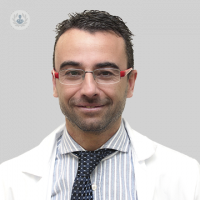Hemorrhoids: Reduce pain is possible
Written by:Hemorrhoidal pathology is one of the most frequent causes of consultation in Coloproctology clinics . Hemorrhoids are physiological plexuses of the anal canal consisting of arteriovenous complexes. Its main function is the sealing of the anal canal in the control of defecation. Most of the symptoms are caused by internal hemorrhoids. The most common symptom is bleeding. In addition to prolapse, being covered with mucosa, can cause fouling, perianal irritation and anal pruritus. Hemorrhoids rarely hurt, unless prolapsed, incarcerated or thrombosis.
Treatment of hemorrhoids
There are a wide variety of therapeutic options for this pathology including hygienic-dietary measures, elastic band ligation, sclerotherapy, infrared coagulation, and surgical treatment.
For the surgical treatment of hemorrhoids, new procedures emerge with the main objective of reducing the pain of conventional hemorrhoidectomy, trying to achieve similar results in terms of efficacy and safety. New techniques include hemorrhoidectomy with special sealants such as the advanced bipolar electro-systolic or ultrasonic device, circular hemorrhoid staining with stapler and Doppler-guided hemorroidal and mucopexy (THD / HAL).
Conventional hemorrhoidectomy includes the Milligan-Morgan and Ferguson techniques, consisting of hemorrhoid excision. The gold standard is still considered to obtain the best results in the long term, however its main complication continues being the important postoperative pain.
Hemorrhoidectomy with special sealants consists of performing the excision of the hemorrhoids with an instrument that performs a bipolar electrothermal or ultrasonic sealing. This technique presents results comparable to conventional techniques with less postoperative pain, since this instrument uses a high frequency current and an active system of feedback control over the released energy, that limits the thermal propagation and reduces the local damage .

Circular hemorrhoid staining (PPH) is a less painful alternative for the treatment of hemorrhoids that consists of stapling of hemorrhoids without removing them. This technique is indicated in grade III hemorrhoids (hemorrhoids that prolapse with defecation and are reduced manually), and which present a circumferential prolapse. Performing this stapling at the rectal level and not leaving wounds in the anal canal causes less postoperative pain. The mechanism of this technique is to reintroduce 2-3cm the hemorrhoidal plexus by circumferentially resecting a mucosal and rectal submucosa that is excess in the area near the hemorrhoidal tissue. The defect is closed simultaneously by the stapler and the hemorrhoidal area is fixed above. This causes a reduction of prolapse and an interruption of arterial flow to hemorrhoids, solving the main symptoms caused by grade III hemorrhoids, which are prolapse, bleeding and pain.
Another new technique for the treatment of hemorrhoids without extirpating them and also producing less postoperative pain is Doppler-guided hemorrhoidal and mucopexy (THD / HAL). The main goal of this technique is also to treat the symptoms of hemorrhoids such as bleeding, pain and prolapse. The technique consists in making a ligature of the maximum arterial flow point that reaches the hemorrhoid, using a very sensitive Doppler. Subsequently, in the same intervention, the mucosa that has undergone prolapse to its original position is raised by points in the rectal mucosa.
Advantages of new hemorrhoid surgery techniques
The main advantage offered by techniques that do not perform excision of the hemorrhoids on which they perform it is the least postoperative pain when not performing surgical aggressions in the anal canal. This reduction of postoperative pain allows a significant decrease in the consumption of analgesics and a return to normal work or normal daily activities earlier than with conventional surgical techniques.


